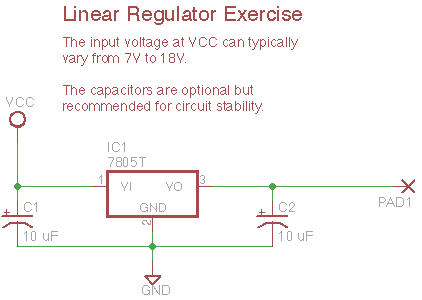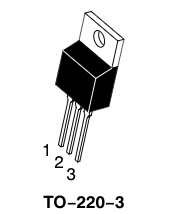4.6.1. Exercise: Voltage Regulation¶
4.6.1.1. Objective¶
Test different types of voltage regulation components.
Power supplies are the heart of any electronics project, as every circuit needs a source of energy, and usually with very specific electrical characteristics. Most of our circuits will require regulated DC supplies, with energy coming either from a battery or the building electrical system. Unless otherwise specified, regulated means the voltage is controlled to a constant level despite changes in the load.
We will use two basic categories of voltage regulators: linear and switching.
In brief, a linear regulator acts as a variable resistor governed by feedback to keep the output voltage at a fixed level. Linear regulators can only step voltages down, and the excess energy is dissipated as heat. So for example, a 5V linear regulator providing a 500 mA current from a 12V supply creates a 7V voltage drop. That represents 3.5 Watts of heat dissipated in the package, which typically means the package needs a good heatsink to carry that heat away.
A switching regulator chops the input current at a high frequency and either pulses it through an inductor (a coil) to generate higher voltages via inductive effects, or filters it through capacitors and/or inductors to generate a lower voltage. The upside of the complexity is much higher efficiency, and hence less heat. The downside is the potential for supply noise, since the switching frequency can appear in the output. But the efficiency almost always outweighs the complexity in consumer applications, especially for battery circuits.
Note that we have already been using many regulators without comment. The Arduino has 5V and 3.3V linear regulators used to supply both the internal and external power busses. All laptops have internal switching regulators to produce the +5V USB output power from the battery supply, and the external AC adapters have switching regulators. The lab supplies include a variable voltage regulation circuit which also includes current limiting for safety.
4.6.1.2. Schematic¶


The diagram shows a 7805 in the common TO-220 leaded package, which has the following connections:
- Input
- Ground (also connected to heatsink tab)
- Output
4.6.1.3. Steps and observations¶
- Wire up the 7805 linear regulator circuit. Be very careful to observe the correct input polarity. Please start with a lab supply, although you substitute a battery to experiment. You may omit the capacitors for this test but they are recommended in a real project.
- Measure the unloaded outputs. The 7805 works fine with no load, but not all switching regulators perform well without any load at all.
- Find a power resistor or component representing a reasonable load. E.g., dissipating 100 mA from a 5V regulator can be accomplished using a 0.5 Watt 50 ohm resistor, or a lamp or motor with similar properties. (Hint: a half-watt 50 ohm resistor can be formed from two quarter-watt 100 ohm resistors in parallel.)
- Measure the loaded output.
- Repeat the same tests using one or more switching regulators. The lab stocks several varieties including step-down (buck), step-up (boost), and ones that can step up or down (buck-boost); many are made by Pololu as small circuit board modules. These are also three-terminal devices with input, output, and ground.
- For the switching regulators, using the oscilloscope try to observe the switching rate as a high-frequency fluctuation on the output. This signal might be 20-100 kHz.
4.6.1.4. Comments¶
In the first example of a linear regulator dropping a 12V input to a 5V output, the the load is only consuming 2.5 Watts of energy while the regulator dissipates 3.5 Watts, so this circuit is operating at only 42% efficiency. Linear regulator circuits are simple to use and inexpensive, so they are applicable for low-power applications or where efficiency and heating are not a problem. The primary advantage is they are potentially low-noise compared to switching regulators, so they often appear in high-fidelity audio applications.
Despite the power inefficiency, we encourage you to use linear regulators such as the 7805 in your projects whenever feasible as they are low-cost and robust and well-suited to simple projects.
In contrast, switching regulators typically operate as 85% efficiency or higher. The availability has been remarkably eased by the introduction of simple integrated circuits which implement the chopping and feedback function. Consumer ‘wall-wart’ power supplies used to only use simple linear regulation (or no regulation), but nearly all modern power supplies for consumer electronics are now switch-mode.
A good debugging heuristic for any project is to begin solving problems by checking the power supply. There are many, many possible problems, so for example:
- overloading a power supply can cause the voltage to drop or current limits to trip
- power supplies connect across every circuit subsystem, so signal problems can be linked in subtle ways
- high-current signals from motors can create voltages in the ground wires (“ground bounce”)
- digital supply noise can couple into analog circuits and inject noise
- etc., etc.
4.6.1.5. Reference¶
4.6.1.6. Other Files¶
- EAGLE file:
7805-regulator.sch